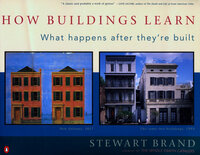Take a photo of a barcode or cover
Truly one of the most interesting books I’ve ever read. Stewart Brand’s writing reflects his clear love of “Low Road” architecture— accessible, seemingly simple but delightfully articulate, betraying deeper truths, thoroughly useful. Though its embodiment is entirely “High Road”— lovingly crafted, maintained and tended by an artisan. The book’s utility and influence has only matured in the 28 years since its publishing.
If you are a human being, read this. If you are an architecture or design student, or are in any way associated with construction/management/planning of buildings, worship and cherish it.
If you are a human being, read this. If you are an architecture or design student, or are in any way associated with construction/management/planning of buildings, worship and cherish it.
The most fun, and interesting take on how buildings evolve (or devolve) over time. Even those not involved in public history, architecture, or urban design will find it interesting. Brand is a total eccentric in the most wonderful of ways. Look up his bio and read this--you won't be disappointed.
informative
reflective
slow-paced
Took me months to slowly absorb this but in the process it has completely changed the way I think about houses, buildings, commercial space, urban space, architecture, and construction, probably forever. As a rank amateur in that field, I needed the best kind of introduction, and this certainly feels like this was it.
No idea where I read about this but so glad I followed it up. Full of ideas and insights on how we alter buildings over time and what that might mean for how we build them in the first place. Very very jealous of the cave and commons model office.
This is my reading reaction I posted to my blog: http://schoolingdotus.blogspot.com
From my last post - this was the only book referred to in the New South Wales matrix that I hadn't yet read. So I set out to grab a copy of How Buildings Learn and discover more about its metaphor for a potential library future.
I think I have always been interested in architecture - take me to any city and I am perfectly happy wandering around to see what I can see in the streetscapes. I knew why I had this interest after a 1997 college guest lecture by James Howard Kunstler. As deeply ashamed as I was at the audience, some of whom booed his talk and belligerently challenged both his ideas and authority in the field, I had a growing sense of excitement and identification. Kunstler was my kind of guy - someone who had figured out that people's relationships with their surroundings profoundly affect their sense of development as a people. "Is this a place worth caring about?" he shouted, showing slides of all-too-familiar suburban landscapes where big box stores held dominion over the horizon and token landscaping replaced once thriving & complex ecosystems. It's no wonder young people feel alienated and isolated, he claimed, pointing to the lack of sidewalks in housing developments and the proliferation of bland "places" that resemble nowhere in particular.
His ideas resonated with me and I was grateful to find the words for things I sensed but was not able to articulate. I found this to be true of Brand's book as well: although one can read this book through the photographs, illustrations, and captions alone, the narrative Brand created is a good one indeed. My favorite reading "moments:"
He quotes from Jane Jacobs on the costs of new construction: "Old ideas can sometimes use new buildings. New ideas must come from old buildings." (p. 28) This quote faces two photos - one of the carriage-style garage where Hewlett-Packard took shape in 1939, and the modest interior of a 1970s garage in Palo Alto where Steves Jobs & Wozniak invented the Apple computer.
In a strange way, libraries are always old buildings because we store the past - we are the metaphoric "old building" that provides a foundation for today's thinkers to build upon.
On p. 188, Brand points out the difference in philosophy of an architect who thinks of a building as a way to manipulate the power structure of those who inhabit it, and the actual inhabitants who will inevitably shape it the way their lives evolve: "A building is not something you finish. A building is something you start."
Libraries are changing organisms just as our users are changing organisms. Our future depends on being flexible, modular, and providing the raw space in which change can flourish.
"Anticipate greater connectivity always."
Beyond being an excellent example of Strunk & White style, this simple declarative sentence is what we should do for our institution as a whole and for the learners that come through our doors. Brand uses this as an introduction to a paragraph on the Berkeley's Wurster Hall conduits, built into the fabric of the building anticipating lots of lovely coaxial cable for television in every classroom. Instead, it proved to be a great way to network computers as the Internet revolution arose. What else could it have connected? Had this empty, "useless" space not been provided, there would have been no opportunity to help the building keep evolving with its inhabitants.
Architecture turns out to have a lot in common with libraries. We deal on a human scale, and help people create places worth caring about, worth inhabiting, and worth growing.
From my last post - this was the only book referred to in the New South Wales matrix that I hadn't yet read. So I set out to grab a copy of How Buildings Learn and discover more about its metaphor for a potential library future.
I think I have always been interested in architecture - take me to any city and I am perfectly happy wandering around to see what I can see in the streetscapes. I knew why I had this interest after a 1997 college guest lecture by James Howard Kunstler. As deeply ashamed as I was at the audience, some of whom booed his talk and belligerently challenged both his ideas and authority in the field, I had a growing sense of excitement and identification. Kunstler was my kind of guy - someone who had figured out that people's relationships with their surroundings profoundly affect their sense of development as a people. "Is this a place worth caring about?" he shouted, showing slides of all-too-familiar suburban landscapes where big box stores held dominion over the horizon and token landscaping replaced once thriving & complex ecosystems. It's no wonder young people feel alienated and isolated, he claimed, pointing to the lack of sidewalks in housing developments and the proliferation of bland "places" that resemble nowhere in particular.
His ideas resonated with me and I was grateful to find the words for things I sensed but was not able to articulate. I found this to be true of Brand's book as well: although one can read this book through the photographs, illustrations, and captions alone, the narrative Brand created is a good one indeed. My favorite reading "moments:"
He quotes from Jane Jacobs on the costs of new construction: "Old ideas can sometimes use new buildings. New ideas must come from old buildings." (p. 28) This quote faces two photos - one of the carriage-style garage where Hewlett-Packard took shape in 1939, and the modest interior of a 1970s garage in Palo Alto where Steves Jobs & Wozniak invented the Apple computer.
In a strange way, libraries are always old buildings because we store the past - we are the metaphoric "old building" that provides a foundation for today's thinkers to build upon.
On p. 188, Brand points out the difference in philosophy of an architect who thinks of a building as a way to manipulate the power structure of those who inhabit it, and the actual inhabitants who will inevitably shape it the way their lives evolve: "A building is not something you finish. A building is something you start."
Libraries are changing organisms just as our users are changing organisms. Our future depends on being flexible, modular, and providing the raw space in which change can flourish.
"Anticipate greater connectivity always."
Beyond being an excellent example of Strunk & White style, this simple declarative sentence is what we should do for our institution as a whole and for the learners that come through our doors. Brand uses this as an introduction to a paragraph on the Berkeley's Wurster Hall conduits, built into the fabric of the building anticipating lots of lovely coaxial cable for television in every classroom. Instead, it proved to be a great way to network computers as the Internet revolution arose. What else could it have connected? Had this empty, "useless" space not been provided, there would have been no opportunity to help the building keep evolving with its inhabitants.
Architecture turns out to have a lot in common with libraries. We deal on a human scale, and help people create places worth caring about, worth inhabiting, and worth growing.
informative
informative
inspiring
medium-paced
Really insightful to making lasting buildings.
This book had a lot of potential. I don't know why, but I couldn't enjoy the text. The illustrations and images were great, and the landscape orientation was very useful for review the evolution of structures, but the words on the page were useless. The idea behind the book, the evolution of buildings, is really cool and I would like to read more on the subject. I wonder if I have have read too many books about buildings and how the built environment affects people that this was too basic for me.
Overall, not peeved that I read it, but happy that it was a lazy Sunday in front of the wood stove, and not some overly complex read, that didn't satisfy.
Overall, not peeved that I read it, but happy that it was a lazy Sunday in front of the wood stove, and not some overly complex read, that didn't satisfy.
I’m not an architect, but as an information architect, I’m curious about how classical architects approach the problems of buildings that people love. This journey led me to Stewart Brand’s book, How Buildings Learn: What Happens After They’re Built. I was first introduced to the book back in 2011 while reading Pervasive Information Architecture. It surfaced again in Nassim Nicholas Taleb’s book, Antifragile, and in Peter Morville’s Intertwingled. In every case, the reference is to how buildings change (or, in Brand’s language, “learn”) over time.
Read more
Read more




